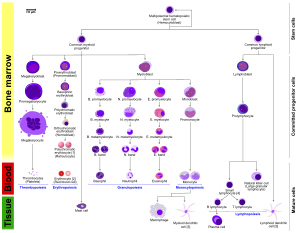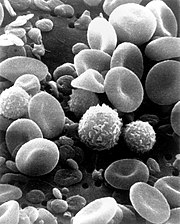Lymphocyte
| Lymphocyte | |
|---|---|
 A scanning electron microscope (SEM) image of a single human lymphocyte | |
| Details | |
| System | Immune system |
| Function | White blood cell |
| Identifiers | |
| MeSH | D008214 |
| TH | H2.00.04.1.02002 |
| FMA | 84065 62863, 84065 |
| Anatomical terms of microanatomy | |
A lymphocyte is a type of white blood cell (leukocyte) in the immune system of most vertebrates.[1] Lymphocytes include T cells (for cell-mediated and cytotoxic adaptive immunity), B cells (for humoral, antibody-driven adaptive immunity),[2][3] and innate lymphoid cells (ILCs; "innate T cell-like" cells involved in mucosal immunity and homeostasis), of which natural killer cells are an important subtype (which functions in cell-mediated, cytotoxic innate immunity). They are the main type of cell found in lymph, which prompted the name "lymphocyte" (with cyte meaning cell).[4] Lymphocytes make up between 18% and 42% of circulating white blood cells.[2]
Types


The three major types of lymphocyte are T cells, B cells and natural killer (NK) cells.[2] Lymphocytes can be identified by their large nucleus.
T cells and B cells
T cells (
Natural killer cells
NK cells are a part of the
They are named "natural killer cells" because they do not require prior activation in order to kill cells which are missing MHC class I.Dual expresser lymphocyte – X cell
The X lymphocyte is a reported cell type expressing both a B-cell receptor and T-cell receptor and is hypothesized to be implicated in type 1 diabetes.[6][7] Its existence as a cell type has been challenged by two studies.[8][9] However, the authors of original article pointed to the fact that the two studies have detected X cells by imaging microscopy and FACS as described.[10] Additional studies are required to determine the nature and properties of X cells (also called dual expressers).
Development

Mammalian
The lymphocytes involved in adaptive immunity (i.e. B and T cells) differentiate further after exposure to an
Characteristics

Microscopically, in a
It is impossible to distinguish between T cells and B cells in a peripheral blood smear.
Typical recognition markers for lymphocytes[14] Class Function Proportion (median, 95% CI) Phenotypic marker(s) Natural killer cells Lysis of virally infected cells and tumour cells 7% (2–13%) CD56 but not CD3T helper cells Release cytokines and growth factors that regulate other immune cells 46% (28–59%) Cytotoxic T cells Lysis of virally infected cells, tumour cells and allografts 19% (13–32%) Gamma delta T cells Immunoregulation and cytotoxicity 5% (2–8%) TCRγδ and CD3B cells Secretion of antibodies 23% (18–47%) MHC class II, CD19 and CD20
In the
Lymphocytes and disease
This section needs expansion. You can help by adding to it. (December 2007) |

A lymphocyte count is usually part of a peripheral
A general increase in the number of lymphocytes is known as lymphocytosis,[16] whereas a decrease is known as lymphocytopenia.
High
An increase in lymphocyte concentration is usually a sign of a
Lymphoproliferative disorders
Low
A low normal to low absolute lymphocyte concentration is associated with increased rates of infection after surgery or trauma.[19]
One basis for low T cell lymphocytes occurs when the
Tumor-infiltrating lymphocytes
In some cancers, such as
Lymphocyte-variant hypereosinophilia
Blood content

History
See also
- Addressin
- Anergy
- Complete blood count
- Cytotoxicity
- Human leukocyte antigen
- Lymphocystivirus
- Lymphoproliferative disorders
- Reactive lymphocyte
- Secretion assay
- Trogocytosis
- All pages with titles containing Lymphocyte
- All pages with titles containing Lymphocytic
Notes
- ^ The process of B-cell maturation was elucidated in birds and the B most likely means "bursa-derived" referring to the bursa of Fabricius.[5] However, in humans (who do not have that organ), the bone marrow makes B cells, and the B can serve as a reminder of bone marrow.
References
- ^ ISBN 0-8153-4101-6.
- ^ ISBN 978-0-323-53045-3.
- ^ ISBN 9780323085939. Retrieved 22 July 2020.
- ^ "NCI Dictionary of Cancer Terms". National Cancer Institute. Retrieved 22 July 2020.
A type of immune cell that is made in the bone marrow and is found in the blood and in lymph tissue. The two main types of lymphocytes are B lymphocytes and T lymphocytes. B lymphocytes make antibodies, and T lymphocytes help kill tumor cells and help control immune responses. A lymphocyte is a type of white blood cell.
- ^ "B Cell". Merriam-Webster Dictionary. Encyclopaedia Britannica. Retrieved 28 October 2011.
- PMID 31150624.
- ^ "Newly Discovered Immune Cell Linked to Type 1 Diabetes". Johns Hopkins Medicine Newsroom. 30 May 2019. Retrieved 9 August 2020.
- S2CID 231809927.
- PMID 32400942.
- PMID 33545037.
- ^ ISBN 0-7216-0008-5.
- PMID 35265979.
- ^ PMID 25656707.
- PMID 15807853.
- S2CID 241913878.
- ^ a b "Lymphocytosis: Symptoms, Causes, Treatments". Cleveland Clinic. Retrieved 22 July 2020.
- S2CID 78707217.
Lymphocytes are recruited into the upper and lower airways during the early stages of a viral respiratory infection, and it is presumed that these cells help to limit the extent of infection and to clear virus-infected epithelial cells.
- PMID 30725847, retrieved 7 October 2023
- S2CID 78729807. Retrieved 5 January 2021.
- S2CID 241056897.
Lymphocytopenia may also be acquired, for example, in patients with HIV infection.
External links
- Histology image: 01701ooa – Histology Learning System at Boston University
- "Cytotoxic T Lymphocyte". Cell Centered Database.
- "Overcoming the Rejection Factor: MUSC's First Organ Transplant". Waring Historical Library.
